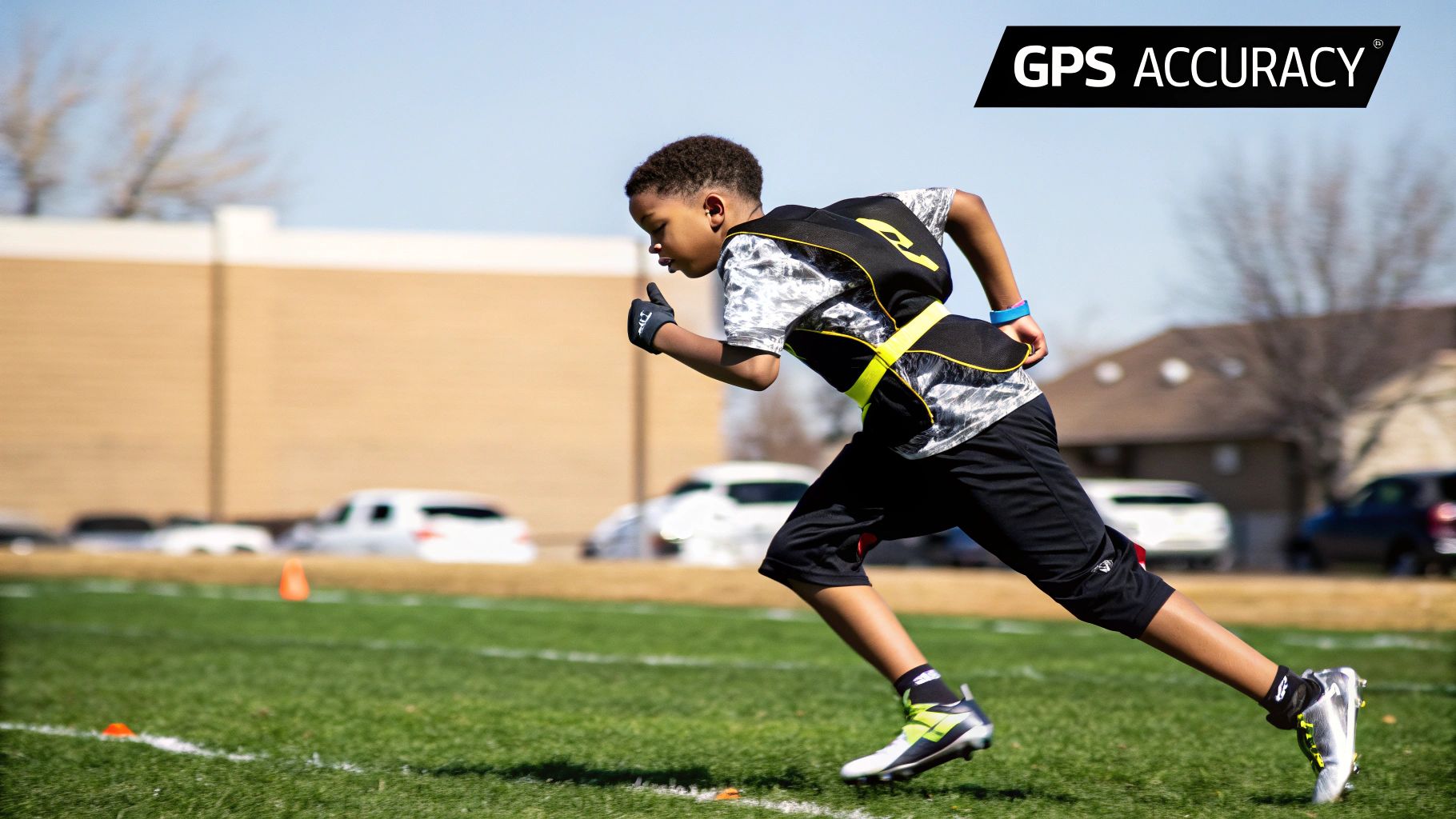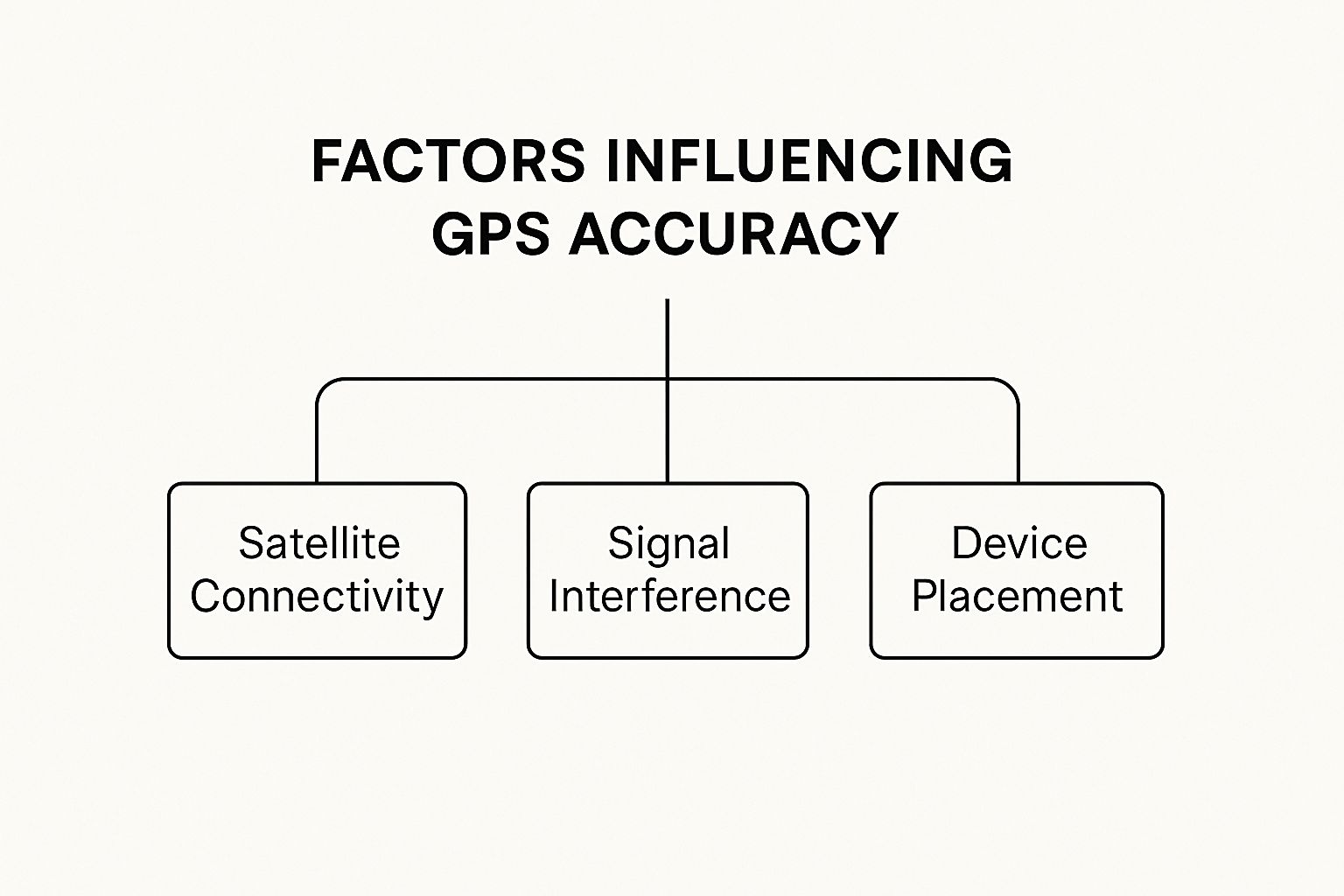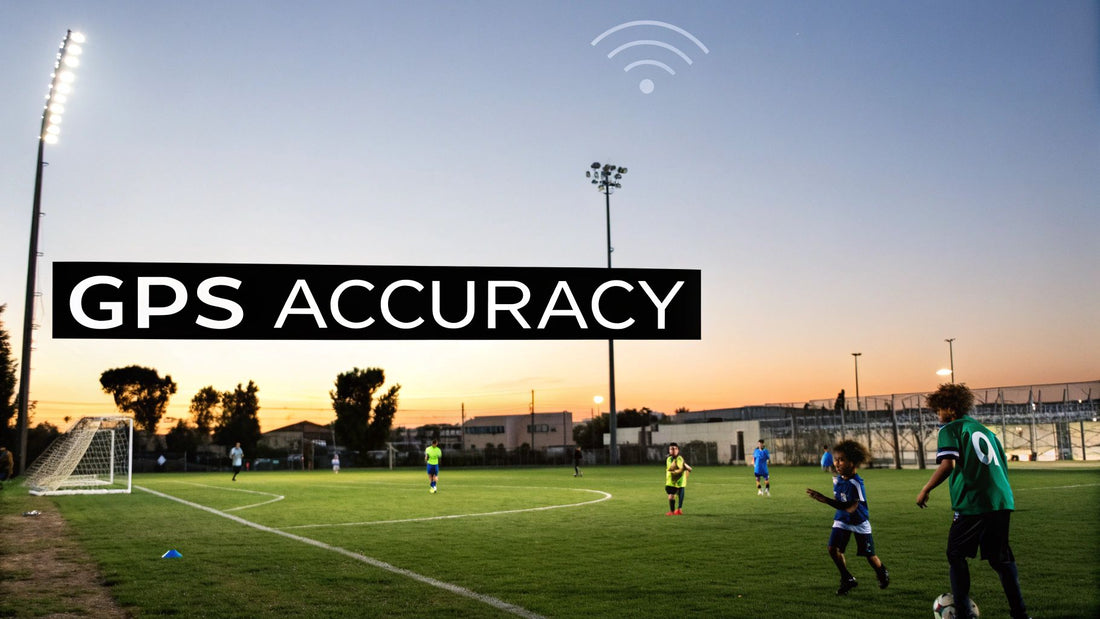When you hear 'GPS tracker', you might picture a simple dot crawling across a map. But in youth football, it’s so much more than just knowing where a player is. Real GPS tracker accuracy in youth football is about capturing every explosive sprint, every sharp turn, and every sudden stop with pinpoint precision.
Why GPS Accuracy Is a Game-Changer for Youth Football

Think of it like this: a standard road map shows you the general route from A to B. But the high-tech telemetry in a Formula 1 car reveals exactly how the driver got there—every gear change, every braking point, every ounce of G-force. That’s the leap accurate GPS brings to the training pitch.
This guide breaks down why this level of detail is completely changing how UK academies approach player development and safety. We've moved beyond guesswork. It’s now about making data-driven decisions that can genuinely shape a young athlete's career.
The Power of Precise Data
Having accurate data on metrics like speed, acceleration, and total distance gives coaches objective insights they can use to nurture talent. For developing players, this information is critical for a few key reasons:
- Managing Fatigue: By tracking a player's total workload, coaches can spot the signs of overexertion long before it leads to burnout or injury.
- Preventing Injuries: Monitoring high-intensity movements helps manage the physical stress on growing bodies, which is a massive help in reducing the risk of common overuse injuries.
- Benchmarking Performance: Objective data allows for fair and accurate comparisons. You can track a player’s progress across a whole season and even see how they stack up against their teammates.
The technology packed into these trackers has come a long way. The accuracy of GPS trackers used in UK youth football has improved massively, especially with the move to 10 Hz devices. These advanced systems can now measure a player's peak speed with a bias of just 1.8% and an error margin of only 0.4 ± 0.45 km/h. That's an incredible level of precision for tracking the fast, dynamic movements seen in football. You can dive into the full research on GPS validity and reliability if you want to get into the nitty-gritty.
In short, pinpoint accuracy turns a simple tracker into an essential tool for the modern game. It gives coaches the clarity they need to protect young athletes while pushing them to reach their full potential, safely and effectively.
What Really Determines GPS Tracker Accuracy
Ever wondered why the stats from one GPS tracker look spot-on, while another seems to miss half the action? Not all trackers are built the same, and understanding what makes a device truly reliable is the first step toward getting data you can trust.
Think of it like getting a clear radio signal in your car—your location and surroundings play a huge part. A tracker's ability to "talk" to satellites is the bedrock of its accuracy. To pinpoint its location, it needs a clean, unobstructed line of sight to several satellites orbiting the Earth. The more satellites it can connect with, and the better their spread across the sky, the more precise that little dot on the map will be.
The Role of Signal and Environment
Just as a radio signal gets fuzzy in a tunnel, a GPS signal can be weakened or blocked. This is a massive deal when it comes to getting high GPS tracker accuracy in youth football. Environmental roadblocks can easily interfere with the signal and spoil your data.
Common culprits include:
- Physical Structures: Think stadium roofs, tall buildings, or even large stands. They can all block satellite signals.
- Natural Obstructions: Dense tree cover around a training pitch can weaken the connection.
- Weather Conditions: Really heavy cloud cover or storms can sometimes have a small impact on signal strength.
It’s a simple chain of events: a good satellite link leads to a strong signal, which means you get accurate data. The infographic below breaks this down.

This shows how everything is connected. To get reliable numbers, you need solid satellite connection, minimal interference, and the device placed correctly.
To help you visualise this, here’s a quick breakdown of what to watch out for.
Key Factors Influencing GPS Tracker Accuracy
This table breaks down the common issues and shows how they might affect data quality during a typical youth football session.
| Factor | Impact on Accuracy | Example in Youth Football |
|---|---|---|
| Satellite Geometry | Low accuracy when satellites are clustered together in the sky. A good spread is crucial. | A player warming up next to a tall stadium wall might only get a signal from one side of the sky, leading to poor positioning data. |
| Signal Obstruction | Physical barriers like buildings, roofs, or dense trees block or reflect GPS signals. | Training on a pitch surrounded by dense, tall trees can cause the tracker to lose connection, missing key sprints. |
| Atmospheric Conditions | Heavy storms or dense cloud cover can slightly delay the signal, causing minor inaccuracies. | During a very rainy match, the reported top speed might be a fraction off due to signal interference. |
| Device Quality & Placement | A cheap GPS chip won't perform as well. Wearing the device incorrectly (e.g., under multiple layers) can also block signals. | A tracker stuffed deep inside a kit bag instead of being worn in a proper vest will give useless, erratic data. |
Ultimately, a bit of awareness about these factors can make a huge difference in the quality of the insights you get.
Why Sampling Frequency Is a Deal-Breaker
Beyond signal strength, the tracker's sampling frequency is probably the most important spec to look at. Measured in Hertz (Hz), this tells you how many times per second the device records a data point. A 1 Hz tracker records once per second. For a slow walk, that’s fine. For football? It’s nowhere near enough.
In a game defined by explosive changes in pace and direction, a low sampling frequency misses the most important moments. It might record the start and end of a sprint but completely skip the peak speed in the middle.
This is why 10 Hz is the gold standard in elite sport. Capturing data 10 times every second gives you the high-resolution picture needed to properly measure sprints, sharp turns, and accelerations. Without it, the stats you’re looking at are incomplete and, frankly, misleading.
These technical details are directly linked to how much you can rely on the performance insights. If you want to dive deeper into the tech, check out our guide to the latest wearable football sensors of 2025.
How Pinpoint Accuracy Shapes Player Development

Knowing the tech behind accuracy is one thing, but seeing it make a difference on the training pitch is where it really clicks. We're moving away from guesswork and "he looks tired" observations. Now, coaches can see a young player’s actual physical output, not just a rough estimate.
This is where GPS tracker accuracy in youth football stops being a spec sheet number and becomes a proper coaching tool.
Good, clean data gives you an objective foundation for making smarter decisions. It cuts through the subjective bias that can easily creep into coaching, replacing gut feelings with hard evidence of what a player is physically doing.
This kind of feedback is massive for developing athletes. When a player smashes a tough drill, accurate data shows you exactly what they put in—far more than you could ever see with your own eyes. It paints a true picture of their limits and their potential.
From Data Points to Development Pathways
Getting acceleration and deceleration metrics right is absolutely crucial for managing training load. For growing players, overuse injuries are a huge concern. Reliable data helps coaches strike that critical balance between pushing hard and allowing for proper recovery, which massively reduces the risk of burnout or strain.
Think about this real-world scenario. A player hits an incredibly high top speed in a sprint drill. Without accurate data, a coach has to wonder: was that a genuine personal best, or just a glitch in the tracker?
With a reliable 10 Hz tracker, however, the coach can trust that number. It lets them see the difference between a player genuinely hitting a new peak and a simple data error. That ensures performance benchmarks are both believable and genuinely meaningful.
You need that level of certainty to build effective, individualised training programmes.
Benchmarking Progress with Confidence
One of the best things about pinpoint accuracy is being able to benchmark a young player against their own history and their teammates. Consistent, reliable data builds a performance timeline, showing real, tangible growth in speed, stamina, and work rate over a season. It helps coaches and players set realistic goals and celebrate genuine milestones.
Here in the UK, using GPS in youth academies has become central to understanding the physical demands at different age groups. For example, detailed studies of U18 players versus U23s and seniors show that U18s cover far less high-speed running distance in matches. This kind of insight, gathered using 10 Hz GPS and accelerometers, highlights the level of detail modern trackers provide. You can read more about the physical demands on youth players.
This objective feedback loop is incredibly powerful. It gives young players clear, factual proof that their hard work is paying off, which is a fantastic motivator.
Creating a Smarter Training Environment
Ultimately, high GPS tracker accuracy in youth football helps build a smarter, safer, and more effective place for players to develop. It gives coaches the power to:
- Tailor Training Loads: Adjust intensity based on what the data says about each player, preventing them from being pushed into the red zone too often.
- Identify Strengths and Weaknesses: Use objective stats to pinpoint areas for improvement, like how quickly a player recovers between high-intensity sprints.
- Support Injury Rehabilitation: Keep a close eye on a player’s physical output as they return to play, ensuring they aren't pushed too hard, too soon.
When you base coaching decisions on data you can trust, you create a development pathway that's not just ambitious but also sustainable. It’s about protecting the long-term well-being of young athletes while helping them be the best they can be.
Turning GPS Data Into Actionable Coaching Insights
A dashboard full of numbers is just noise without context. The real magic happens when coaches can translate that raw data into smarter training decisions that protect and develop young players. This is where the importance of GPS tracker accuracy in youth football truly comes alive.
Let's break down a few key metrics that every coach should have on their radar. Metrics like PlayerLoad, high-speed running distance, and the number of sprints aren't just abstract figures; they are direct indicators of the physical stress a player is under.
For example, a sudden spike in a young athlete's PlayerLoad from one week to the next can be a huge red flag for overtraining. Spotting this early means you can step in, perhaps by dialling back their training intensity or scheduling an extra recovery day, and potentially stop an injury before it even happens.
Understanding Player Workload
One of the most powerful concepts in modern sports science is managing a player's workload to keep them in that sweet spot—challenging them enough to improve, but not so much that they tip over into fatigue and injury. The key tool for this is the acute:chronic workload ratio (ACWR).
It sounds complicated, but the idea is actually quite simple.
- Acute Workload: This is what the player has done in the last week (think of it as their "hard" week).
- Chronic Workload: This is their average workload over the last four weeks (this is their "fitness base").
By comparing the two, you get a ratio that tells you if a player’s recent training is appropriate for their current fitness level. A ratio between 0.8 and 1.3 is widely considered the 'sweet spot' where fitness improves with minimal risk of injury.
This ratio turns technology into a genuine partner in player care. It helps keep young athletes fit and challenged, but crucially, not overloaded—which is absolutely vital for their long-term health and development.
Of course, the accuracy of the data feeding these calculations is everything. Top youth academies across the UK rely on this precision for both injury prevention and performance. Research from the University of Brighton has shown that professional 10 Hz GPS devices provide reliable measurements for key actions like acceleration and deceleration with very low error margins, making them solid tools for managing the stop-start demands of youth football. You can find more from the University of Brighton's research on training load monitoring.
By turning accurate data into real-world insights, coaches can create a safer, more effective training environment. For a deeper dive into the metrics and what they mean, check out our complete guide on football GPS tracking. It’s not about letting the data run the show; it's about using it to make more informed and empathetic coaching decisions.
A Practical Checklist for Optimising GPS Accuracy
Getting reliable data all comes down to good habits. While the tech inside a GPS tracker is seriously complex, ensuring you get the best possible GPS tracker accuracy in youth football boils down to a few simple, repeatable steps. A consistent routine is your best friend here—it cuts out the variables that can mess up your data.
Think of it like a pre-match warm-up; skip it and performance suffers. It's the same deal here. If you neglect these quick pre-session checks, you'll end up with wonky or incomplete data, which makes your post-session analysis pretty much useless. This checklist gives you straightforward, practical tips to get insights you can actually trust, every single time.
Before the Session Starts
Preparation is everything. A few minutes spent before players even get their boots on can make a world of difference to the quality of your data. This isn't just about flicking a switch; it's about setting the tech up for success.
- Fully Charge Every Device: Start every single session with a 100% charge. A low battery can sometimes drag down performance, so make this a non-negotiable part of your routine.
- Get a Solid 'GPS Fix': Before the warm-up, take all the trackers out of the bag. Lay them outside, face up, with a clear view of the sky for at least 5-10 minutes. This gives them time to lock onto multiple satellites and establish a strong connection—a process known as a 'GPS fix'.
- Check for Software Updates: Keep an eye on the companion app for any firmware updates. Manufacturers are always rolling out improvements that boost accuracy and squash bugs.
During the Session
Once the session kicks off, the focus moves from the device itself to how it’s worn. This part is crucial. Correct placement is the key to avoiding phantom movements and ensuring the tracker captures a player’s true physical output. A vest that’s too loose will give you noisy, unreliable data every time.
The goal is to make the tracker feel like an extension of the player. It should move with their body, not bounce around on its own. A proper fit ensures the data reflects the athlete's effort, not just a wobbly bit of kit.
Follow these steps to get the fit right:
- Insert the Tracker Correctly: Pop the GPS unit into the purpose-built pocket on the vest. You’ll usually find it sitting right between the shoulder blades.
- Ensure a Snug Fit: The vest needs to be tight against the player's torso, but not so tight that it restricts their breathing or movement. If it's loose, the tracker will bounce around and create false spikes in your acceleration and deceleration data.
- Position It Over a Base Layer: For comfort and extra stability, players should always wear the GPS vest over a base layer or training shirt, never directly on their skin.
By building these simple pre-session and in-session habits, you lay the groundwork for collecting high-quality, actionable data that genuinely reflects how your players are performing on the pitch.
How to Choose the Right GPS System for Your Team
Picking the right GPS system for your youth team can feel overwhelming, but it really just comes down to knowing what actually helps young players develop. Once you understand why GPS tracker accuracy in youth football is so important, the decision gets a lot easier.
The absolute deal-breaker? A high sampling rate.
Anything less than 10 Hz—which means recording ten data points every second—is just too slow to catch the quick, explosive bursts of movement that football is all about. It’s the gold standard for a reason. This should be your first and most important filter when looking at different options.
Features That Matter for Youth Football
For youth teams, the best systems are simple and tough, not the complicated analytical machines built for pro clubs. A lot of high-end systems will throw fancy metrics at you that, while interesting, don’t add much practical value at the grassroots level and just make everything more confusing.
Instead, zero in on these core features:
- Ease of Use: The software needs to be simple and clear. You should be able to find and understand key stats like distance covered, sprint speed, and player load without needing a degree in sports science.
- Durability and Battery Life: Let's be honest, the trackers are going to take a beating. Look for tough, well-made devices that can handle tackles and tumbles. Ensure the battery will easily last through a long training session and a full match day.
- Reliable Customer Support: When something goes wrong (and it will!), good customer support is a lifesaver. Check reviews from other grassroots clubs to see what their experience has been like.
Choosing a system is about more than just the tracker. You're investing in a complete package that should help your team grow. A user-friendly platform with solid support is often far more valuable than a system overloaded with features you'll never use.
At the end of the day, the best GPS system is one that fits your budget, is easy for your coaches to get the hang of, and gives you accurate data you can use. For a deeper dive into the options out there for younger teams, our guide on the best GPS tracker for grassroots football can help you make a smart choice.
Still Got Questions About GPS Accuracy?
It's natural for coaches and parents to wonder about the nitty-gritty details of GPS trackers. Let’s tackle a few of the most common questions to clear things up and help you get the most out of the tech.
How Accurate Are GPS Trackers for Short Sprints?
This is a big one. The good news is that modern 10 Hz GPS trackers are brilliant at capturing those short, explosive bursts of speed. They can measure a player's peak speed with a tiny margin of error, often as low as 0.4 km/h.
That level of precision is exactly what you need to reliably monitor the high-intensity efforts that really matter in football. It gives coaches data they can trust to track performance and manage fatigue.
Does Bad Weather Affect GPS Tracker Accuracy?
Yes, it can sometimes play a part. Think of it like a radio signal—really heavy cloud cover, thick fog, or a proper downpour can slightly weaken the connection to the GPS satellites. In turn, that could reduce data accuracy a little.
That said, professional-grade systems are built to be tough. To get the best results, just make sure the device has a solid satellite lock before a session starts, especially if the weather looks a bit dodgy.
Is GPS Tracking Worth It for Under-12s Teams?
While the technology is spot-on, its real power lies in managing physical load to boost performance and cut down on injuries. For the youngest age groups, like the Under-12s, the focus should always be on having fun, learning the basics, and falling in love with the game.
GPS tracking really comes into its own from the U13 and U14 age groups and up. That's when structured physical conditioning starts becoming a bigger piece of the training puzzle, and the data becomes genuinely useful.
At SoccerWares, we provide the tools that help young athletes develop safely and effectively. Explore our range of high-performance GPS trackers and other essential training gear by visiting us at https://soccerwares.com.

